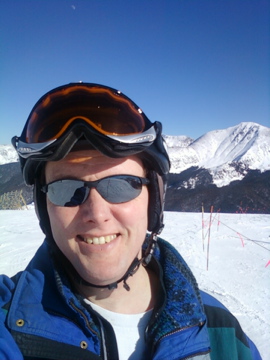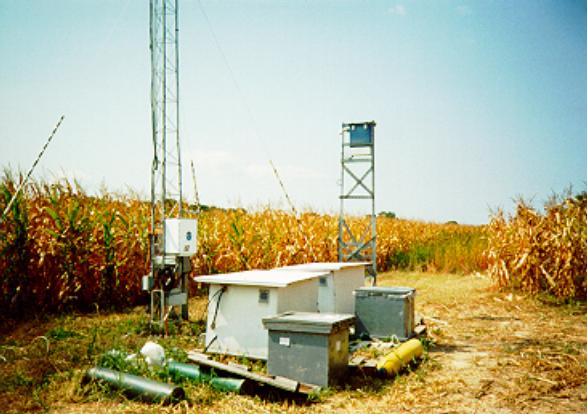|
Research:
I set up a remote site on the
Eastern Shore of the Chesapeake Bay, where instruments monitor ozone,
carbon monoxide, sulphur dioxide, carbon dioxide, total ultraviolet
light, and NO y (total reactive
oxides of nitrogen). I examined correlations of NOy with CO
and SO2 to determine the relative
importance of different reactive nitrogen sources. Positive
correlations of NOy with SO 2 indicate coal combustion sources,
while positive correlations with CO point to mobile sources such as
automobiles. In addition, I have used a back trajectory model (HYSPLIT)
to determine the origins of the
air parcels carrying these gases.
In 1999, I spent seven weeks in the Indian Ocean measuring
trace gases and aerosols for the INDOEX project. See here for pictures, ship tracks, and some
graphs. We found that ozone
is transported over the Indian Ocean, with the Indian subcontinent as
the
primary source, instead of downward mixing, as had been previously
suggested,
and also that ozone destruction may be occurring at a faster rate than
can
be explained by conventional HOx chemistry alone. CO is also
advected away from the continents, and serves as a tracer for
anthropogenic pollution, indicating, for example, that the ITCZ serves
as a barrier to mixing between air from the Northern Hemisphere and
Southern Hemisphere.
Also in 1999, I flew temperature, relative humidity, pressure
altitude, SO2, O3
, CO on board a small airplane (single-engine Cessna 172 or twin
engine Piper Aztec, depending on the flight) in Philadelphia, PA for
the
NE-OPS (Northeast Oxidant Particle Study) project. The impact of
local ozone production as well as transport became quite clear as we
observed upwind profiles with uniform, elevated ozone levels and
downwind profiles with high ozone in the boundary layer. One day
in particular showed the importance of local circulation and
small-scale effects in determining ground-level air quality, as a
strong sea breeze blew all the way from the New Jersey coast, inland
and past Philadelphia. The air at the surface was clean air from
over the Atlantic Ocean, while the air only a couple hundred meters
above was clearly the same polluted air that had been present over the
city all day. When the front of the breeze blew in, winds shifted
suddenly by 90 degrees, and ozone and CO levels both dropped
dramatically at the surface.
I am running the EPA Models-3/CMAQ air quality model, doing
some
local air quality modeling. Our aims were to determine the impact
of
Ohio River Valley sources on Maryland air quality, and to get some idea
of
the relative importance of local and regional sources of air pollution.
The
goals of this program are, to some extent, wide open, though we plan to
do numerous sensitivity tests, and possibly do some ensemble-style runs
of CMAQ for air quality planning purposes. We finished the
January/February 2002 for the OTR's SIP modeling. Our analysis of
CMAQ's predictions and a comparison with observations suggested that
Maryland's air quality might be considerably better than
predicted! In 2009, that was the case, but only time will
tell if we were right.
I have also written a conceptual model of Mid-Atlantic air
quality
in conjunction with MARAMA.
We have recently measured aerosols and air pollution from an
aircraft and from surface sites in China as part of the EAST-AIRE
project. NASA and NSF teamed up with the Chinese government to
support this project. The conclusion is that China suffers from
local, transported, and natural air quality problems. Dust storms
are a frequent menace, but the dust also comes covered with a modern
industrial coating of soot and sulfur. The people of China
already know this: in Shenyang, they wear masks all winter long,
and discard them at the end of the day.
We are also working on the radiative properties of coated soot
particles. Conceptually, imagine how a sidewalk appears much
darker when it's wet. The same (not completely for the same
reasons) holds true for aerosol particles that have been "wetted" with
a sulfate/water coating. They appear darker, sootier, and more
absorbing. The impacts on climate change and photochemistry are
potentially enormous. Several earlier authors pioneered this
reasearch, and we are now pushing it into the lab to see how well these
ideas hold up when used to examine aerosols with known size and
composition.
I am a busy pup this year! I am also working on
ruggedizing an ammonia detector for use in estimating ammonia
emissions. We are working with Dr. Melody Avery of NASA/Langley
on the experiment design. We have not had a wave of volunteers
for this duty, however, since it involves sitting in the plume of a hog
barn on hot summer days. Wonder why? The experiment will be
an intriguing one, since the swine production facility is a USDA
experiment station, so we will know exactly
what those hogs are eating!
I am the director of the Maryland aircraft research
program. On most polluted days in summer, we fly our aircraft
upwind and downwind of the Baltimore-Washington, D.C. metropolitan
areas to investigate air pollution. The data are then used to
evaluate models, improve and evaluate satellite retrievals, and look
for trends in air quality data. We also use the data on an
episodic basis to examine the nature of particular air quality
events. Look for us in the skies next time you hear it's a code
orange air quality day!
I am working with Marcos Andrade, a recent graduate of the
department, who has recently moved to Bolivia. Marcos and I are
looking into measuring some trace gases at Bolivian air quality sites,
and collaborating on the low level jet over the Bolivian part of the
Amazon.
I direct field operations for the National Acid Deposition
Program's MD99, Beltsville, Maryland site.
I am working with several colleagues at EPA and NASA on
nitrogen deposition to the Gulf of Mexico and its watershed. This
project involves evaluations of precipitation from a metorological
model, evaulating the nitrogen deposition from an air quality model,
and putting the results of those models into a water quality
model. The water quality model then predicts nutrient flow down
the Mississippi and into the Gulf itself. We aim to improve the
simulation by evaluation with satellite data and by adding lightning
NOx emissions to the model.
On the side, I also do some consulting on patents, forensic
meteorology, air pollution and the like, and I perform improvisational
comedy around town.
Future interests include: development of a cloud sensor
for
radiosondes; and measurement of SO2 and sulfate over
the East Coast via satellite, airplane, and at the surface.
|






